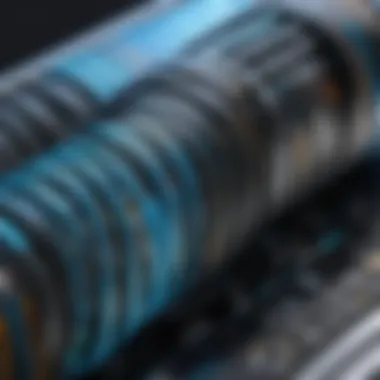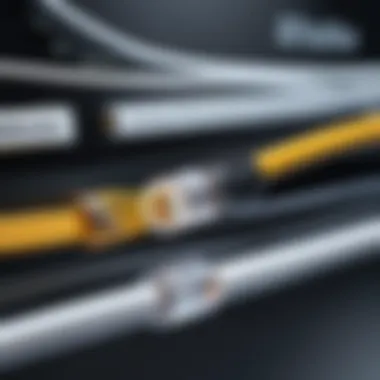In-Depth Analysis of 20 Foot Ethernet Cables on Amazon


Intro
In today's increasingly digital world, the performance of our network connections is paramount. Ethernet cables play a crucial role in establishing stable and high-speed connections, making them essential for both work and play. Among the various lengths available, the 20-foot Ethernet cable stands out as a practical choice for many users, offering flexibility while maintaining optimal performance. This article aims to provide an extensive examination of the features, specifications, and user experiences associated with 20-foot Ethernet cables found on Amazon.
By considering different factors such as cable standards, user feedback, and competitive evaluations, readers will gain a clearer understanding of whether this specific length fits their needs. We will explore key attributes, performance metrics, installation considerations, and the advantages or disadvantages these cables may present. Through this thorough exploration, users ranging from casual consumers to technology aficionados can navigate their options with confidence.
Understanding Ethernet Cables
Ethernet cables are pivotal in establishing reliable connections within computer networks. They serve as a link between devices, enabling them to communicate effectively. The significance of understanding Ethernet cables lies in the various applications they offer, ranging from home networks to office environments. A good grasp of their specifications, performance metrics, and categories will help in selecting the right cable for your needs.
What is an Ethernet Cable?
An Ethernet cable is a type of network cable used to connect devices such as computers, routers, and switches in a wired network. Its main function is to transmit data packets between devices. Ethernet cables can vary in terms of speed, distance, and the technology they utilize. The most commonly known types are twisted pair cables, which reduce interference and enhance performance.
Categories of Ethernet Cables
Ethernet cables come in several categories, each designed for specific applications and performance levels. Here are some key categories:
Category (Cat )
Category 5 cables are among the earliest types used in Ethernet networks. They support data transmission speeds of up to 100 Mbps at a maximum length of 100 meters. Their popularity stems from cost-effectiveness and sufficient performance for basic networking tasks. However, Cat 5 cables are gradually becoming outdated, as newer technologies have emerged that offer better performance and reliability.
Category 5e (Cat 5e)
An improvement over Cat 5, Category 5e cables provide enhanced capabilities, supporting speeds of up to 1 Gbps. This upgrade is vital for modern applications like video streaming and online gaming. Additionally, Cat 5e cables reduce crosstalk, which is a common issue in Ethernet connectivity. This makes them a beneficial choice for home and small office networks, offering a good balance between performance and price.
Category (Cat )
Category 6 cables are engineered for higher performance, accommodating data speeds of up to 10 Gbps over shorter distances, typically around 55 meters. They are essential for environments where high bandwidth is necessary, such as data centers and large enterprise networks. The construction of Cat 6 cables includes stricter specifications for crosstalk and system noise, making them a preferable choice for serious users who prioritize speed.
Category 6a (Cat 6a)
Category 6a cables are an enhanced version of Cat 6 and support data rates of up to 10 Gbps over a full 100 meters. They are suitable for high-demand applications and are often used in professional setups. The additional shielding in Cat 6a cables contributes to superior protection against interference, resulting in better signal quality. For this reason, they are a popular option in environments that require robust connectivity.
The Significance of Foot Length
The length of an Ethernet cable significantly impacts its performance and usability. A 20-foot Ethernet cable strikes a balance between convenience and functionality. It offers enough distance to connect devices without leading to signal degradation, which is a common concern with longer cables. Understanding the specific applications and benefits of this length is essential for making informed decisions.


Ideal Use Cases for Foot Cables
Connecting Devices in Home Offices
In a home office setup, the arrangement and distance between devices can vary greatly. A 20-foot Ethernet cable allows for optimal flexibility in positioning. This length is particularly useful for connecting computers to routers or switches without cluttering the workspace. Moreover, it facilitates a tidy environment by minimizing the need for additional extension cords or power outlets. The physical characteristic of this cable length helps maintain a reliable internet connection, which is vital for productivity.
Gaming Setups
Gamers benefit from the low latency and stable connection provided by a well-regulated Ethernet cable. A 20-foot cable enables connection of gaming consoles to a router, offering flexibility in room layout. The key aspect of this setup is that it reduces lag during play, enhancing the overall gaming experience. While shorter cables restrict movement, a 20-foot length allows for comfortable positioning of chairs and furniture while still keeping a strong connection.
Media Streaming Areas
For media streaming, a 20-foot Ethernet cable is advantageous as it connects streaming devices to the internet reliably. This length is ideal for larger entertainment setups, where the router may be distant from the TV or media hub. The consistent data transfer speed offered by a 20-foot cable ensures smooth streaming of high-definition content. This setup minimizes buffering and disruptions, providing an enjoyable viewing experience. While longer cables might complicate arrangements or lead to signal loss, 20 feet represents a sweet spot for many households.
Advantages Over Shorter and Longer Cables
The 20-foot Ethernet cable has distinct advantages over both shorter and longer alternatives. For shorter cables, the limited reach can lead to awkward setups or positioning less than ideal for device connectivity. Longer cables, though offering distance, often introduce issues like increased resistance, potential signal loss, and greater clutter. In contrast, a 20-foot cable effectively supports a robust connection while maintaining manageable lengths that suit various environments. Therefore, it is a practical solution for many users seeking reliable performance and convenience.
Selecting Foot Ethernet Cables on Amazon
Choosing the right 20 foot Ethernet cable is crucial for ensuring optimal performance in various settings. The selection process can be overwhelming, given the multitude of options available on Amazon. Therefore, understanding the essential factors and product specifications is key to making an informed decision. This section aims to guide readers through the significant considerations when buying a 20 foot Ethernet cable, providing insights that will ultimately enhance their user experience.
Factors to Consider When Buying
Price versus Quality
When exploring Ethernet cables, the balance between price and quality often arises as a fundamental point of consideration. Ethernet cables vary widely in price, but a lower price does not always imply lower quality. In fact, investing in a quality cable can yield better performance and longevity. For instance, a well-manufactured Cat 6 cable might cost more than a Cat 5e option but can deliver faster data transfer speeds and superior shielding.
The key characteristic here is the cost-to-performance ratio. An informed decision should consider how the cable's quality directly influences connection reliability, especially if the cable is used for gaming or streaming video.
However, it is essential to avoid overpaying based on brand marketing alone; checking user reviews can provide insight into whether the price aligns with actual performance.
Brand Reputation
Brand reputation plays a critical role in the buying decision for Ethernet cables. Established brands often have a history of reliability and customer satisfaction. Products from well-known companies are likely to meet higher standards and go through more rigorous testing.
A key characteristic of acknowledging brand reputation lies in trustworthiness. Brands like Cable Matters and AmazonBasics have built a reputation over the years, producing quality products that consumers repeatedly endorse.
Nonetheless, choosing a lesser-known brand isn't inherently bad, especially if reviews indicate solid performance. The challenge lies in balancing the familiarity of brands with lesser-known options that may offer comparable quality at a lower cost.
Compatibility with Devices
Compatibility with your existing devices is crucial when selecting an Ethernet cable. Not all cables work perfectly with every device, and understanding this aspect can prevent connectivity issues.
A key characteristic of this factor is ease of setup. For instance, Cat 6 cables are ideal for new technology requiring higher bandwidth. They offer faster speeds necessary for devices like gaming consoles and smart TVs. Choosing a compatible cable can significantly improve user experience, making it simple to plug and play without daunting setup challenges.
Product Specifications to Look For
Data Transfer Speed


One of the most vital specifications to consider when purchasing Ethernet cables is data transfer speed. The speed influences everything from how quickly files can be downloaded to the quality of streaming services.
The key characteristic here is the bandwidth capacity. Most 20 foot Ethernet cables will specify their maximum data transfer speeds, typically varying between 100 Mbps (for Cat 5e) to over 10 Gbps (for Cat 6). This aspect is particularly essential for users engaged in high-bandwidth activities like gaming or 4K streaming. Opting for a cable with higher speeds can future-proof your setup, ensuring compatibility with advancements in technology.
Shielding Type
The shielding type of an Ethernet cable impacts its ability to resist interference. Among the commonly known types are unshielded twisted pair (UTP) and shielded twisted pair (STP).
The key characteristic of shielding quality is protection against interference. Cables with better shielding can maintain performance even in environments with electronic noise. For instance, if the cable runs near power sources or other electronics, an STP cable could alleviate potential issues. Understanding this aspect can help users avoid frustrating disconnections and maintain steady connections across devices.
Jacket Material
The jacket material is another important specification that often gets overlooked. The jacket protects the wires inside and can significantly impact the cable's durability.
The key characteristic here is build quality. Common materials include PVC and low smoke zero halogen (LSZH). While PVC is widely used and cost-effective, LSZH offers better safety features—ideal for environments where flammability is a concern. Consumers should weigh the long-term benefits of investing in a more durable jacket material against their immediate cost, as a resilient exterior can enhance cable longevity in the long run.
Top Rated Foot Ethernet Cables on Amazon
The importance of identifying top rated 20 foot Ethernet cables on Amazon lies in the ever-increasing need for reliable connectivity. Given that many users require stable connections for various activities like gaming or streaming, finding the best products becomes paramount. These cables ensure optimal performance, reducing lag and interruptions. The right choice not only enhances internet speed but also contributes to overall user satisfaction.
Product Reviews Summary
In today's market, product reviews play a critical role in guiding consumers. When examining 20 foot Ethernet cables, looking at user experiences brings clarity to their actual performance. Amazon hosts a plethora of reviews that provide insight into every aspect of the product, from build quality to data transfer efficiency.
Here, users can share their personal experiences, highlighting significant strengths and occasional weaknesses. Many top-rated cables receive high scores due to their durability and speed.
"Quality cables not only deliver performance, but also have a longer life span, making them worth the investment."
Comparison of Best Options
When choosing among the best options, two categories tend to stand out: Cat 5e and Cat 6. Each comes with its own specifications and use cases that cater to different needs and environments.
Cat 5e versus Cat
The primary aspect to consider in the Cat 5e versus Cat 6 debate lies in their respective capabilities. Cat 5e cables support speeds up to 1 Gbps, ideal for most home setups. In contrast, Cat 6 can support up to 10 Gbps over shorter distances. This difference is crucial for users who engage in high-bandwidth activities, such as online gaming or streaming in high definition.
The key characteristic of Cat 6 is its increased shielding, which helps minimize crosstalk. This contributes to a cleaner signal and better overall performance. For many, the minor price increase is justified by the added performance capabilities of Cat 6.
User Ratings and Feedback
User ratings and feedback reflect the real-life functionality of Ethernet cables. They offer a broad spectrum of opinions, helping prospective buyers gauge what to expect. Users voice their satisfaction about stability and speed, while some might express concerns about build quality or length discrepancies.
Key ratings highlight how certain cables withstand wear and tear, essentially debating longevity and reliability. For many, the most common feedback is regarding value for money. Overall, higher ratings often correlate with performance in typical usage scenarios, making user feedback a valuable asset in making purchasing decisions.


Common Issues with Ethernet Cables
In any technical field, the understanding of common problems is vital to ensuring efficiency and reliability. When it comes to Ethernet cables, particularly the 20-foot variants, being aware of these issues can significantly enhance user experience and device connectivity. This section provides crucial insights into prevalent challenges faced by users and the approaches to mitigate them. Addressing these issues enables both casual consumers and tech enthusiasts to make informed decisions when purchasing and utilizing Ethernet cables, ultimately optimizing their technology setup.
Performance Problems and Troubleshooting
Performance problems with Ethernet cables often stem from several factors, including incorrect cable category, poor connections, and environmental interference. Users may experience slow data transfer rates or intermittent connectivity, which can hinder online activities like gaming or streaming.
To troubleshoot these issues, consider the following steps:
- Check the Cable Category: Ensure that your cable meets the demands of your usage environment. For instance, using a Cat 5e cable for high-speed internet may not yield optimal results.
- Inspect Connections: Loose or worn connectors can lead to data loss. Make sure both ends of the cable are securely connected to the devices.
- Look for Physical Damage: Check for fraying or kinks in the cable, as these may also cause performance drops.
- Avoid Interference: Ethernet cables should be routed away from sources of electromagnetic interference, such as microwave ovens and fluorescent lights, which can affect signal quality.
Understanding these elements allows users to effectively diagnose and remedy common performance issues with Ethernet cables.
Longevity and Durability Factors
The longevity and durability of Ethernet cables are crucial, particularly in a setting where regular usage is expected. Several factors influence the lifespan of an Ethernet cable, including material quality and environmental exposure.
Key considerations include:
- Material Quality: Higher quality materials, such as copper conductors, typically result in better performance and longevity compared to lower-grade materials.
- Jacket Material: The outer jacket of an Ethernet cable serves as protection against environmental hazards. Cables with higher quality jackets, such as those made of PVC or low-smoke zero-halogen (LSZH) materials, can last longer and are more resistant to wear and tear.
- Usage Environment: Cables exposed to harsh conditions—like extreme temperatures or humidity—may degrade faster. For example, running cables outdoors without adequate insulation can accelerate deterioration.
By recognizing these longevity factors, users can select Ethernet cables that not only meet their current needs but also endure the test of time, minimizing future replacements and maintaining consistent performance.
Culmination
The conclusion segment of this article serves a vital role in encapsulating the essence of exploring 20-foot Ethernet cables. It emphasizes several key components that aid the reader in understanding the relevance of the information presented. By summarizing the discussions from previous sections, it reinforces the importance of informed purchasing decisions in the field of networking. The right Ethernet cable significantly influences performance in various settings, such as home offices, gaming setups, and media streaming areas.
In examining 20-foot Ethernet cables specifically, we highlight the ideal scenarios where this length excels compared to shorter or longer options. Consumers can appreciate the practical advantages, such as reduced latency and enhanced connectivity. Moreover, factors like data transfer speed, shielding type, and jacket material become crucial considerations when selecting a suitable product. The insights provided can help potential buyers identify the essential qualities that align with their unique needs.
Overall, this conclusion encapsulates how understanding the functionalities of these cables, alongside user feedback, can lead to better consumer decisions. The challenge lies in balancing quality and price while also considering device compatibility. A well-informed choice ensures that consumers maximize their investment in technology.
Summarizing Key Points
- Understanding Ethernet Cables: A foundational overview of Ethernet cables and their categorization helps clarify the specifications of a 20-foot option.
- Significance of Length: Recognizing the specific uses of 20-foot Ethernet cables reveals why this length is popular among various user groups.
- Selection on Amazon: Key buying factors, such as brand reputation and product specifications, guide users toward the most reliable options available.
- Common Issues: Addressing performance problems and durability concerns allows for a more profound comprehension of everyday experiences with Ethernet cables.
- User Insights: Feedback and product reviews provide additional layers of information that can heavily influence purchasing decisions.
Final Thoughts on Purchasing Decisions
When considering the purchase of a 20-foot Ethernet cable, consumers should not only evaluate the immediate requirements but also anticipate future needs. A good cable should provide reliable performance and durability to withstand the rigors of daily usage. Taking the time to read product reviews, understand user feedback, and compare specifications across different brands can lead to a much more satisfying end result.
Investing in quality Ethernet cables is essential for optimizing network connections. Consumers should aim for cables that not only meet their current needs but also offer room for growth and adaptability. Thus, weighing the pros and cons, while actively seeking information, is key to making informed decisions that enhance one's digital experience.
"Knowledge is the best tool for making empowered choices, particularly in technology where specifications often dictate performance outcomes."
In summary, the journey through the realm of 20-foot Ethernet cables highlights the importance of understanding specifications, leveraging user insights, and recognizing optimal use cases. Such analyses enable consumers to make thoughtful purchases that yield long-term benefits.



